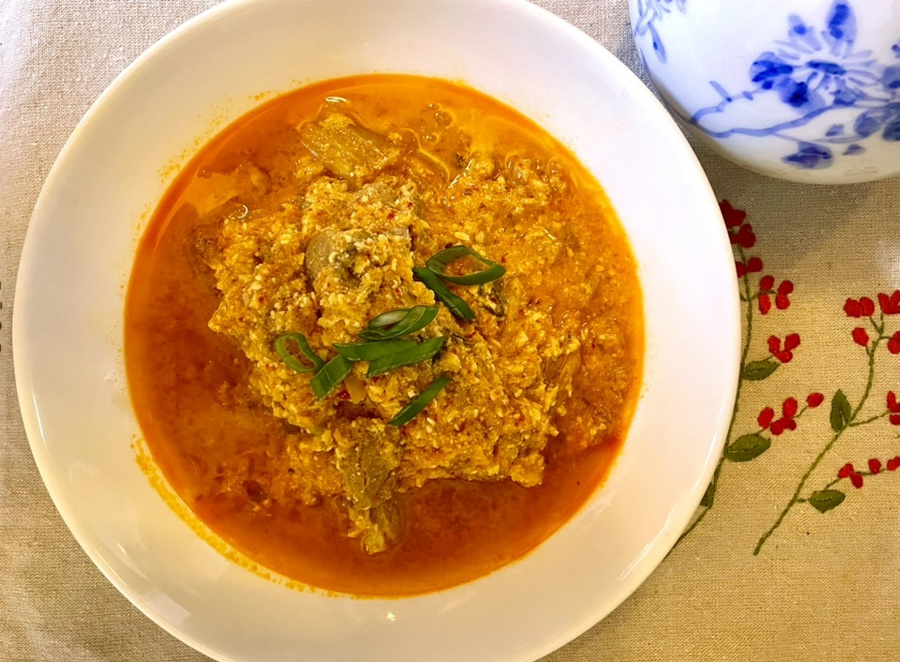Rich and Savory Pork and Kimchi Soy Bean Paste Stew (Bijijjim)
How to Make Delicious Soy Bean Paste Stew (Bijijjim)

Just as a good tofu restaurant naturally serves delicious tofu, their soy bean paste (biji) is also wonderful! Whenever I buy tofu, the kindhearted tofu shop owner always asks if I need any ‘biji’ (the leftover pulp after making tofu). While I don’t always take it as it can be a bit much, it’s incredibly versatile. You can use it instead of tofu in ‘ssamjang’ (dipping sauce) to lower saltiness, boost nutrition, and adjust thickness. Mixed with finely chopped vegetables, it makes a wonderfully nutty and delicious ‘biji-jeon’ (savory pancake). Today, I’m making a hearty Bijijjim with plenty of pork and kimchi. Enjoying this thick, savory stew with rice is incredibly comforting and satisfying. It’s a humble yet deeply flavorful dish perfect for a home-cooked meal.
Ingredients- Fresh soy bean paste (Biji) 2 cups
- Pork (shoulder or butt) 300g
- Well-fermented Kimchi 1/4 head (about 200g)
- Anchovy-Kelp Broth 700ml
- Gochugaru (Korean chili flakes) 1 Tbsp
- Soy sauce for soup (Gukganjang) 1 Tbsp
- Salted fermented shrimp (Saeujeot) 2 Tbsp, minced
- Minced garlic 1 Tbsp
- Chopped green onions 2 Tbsp
- Soju or cooking wine 2 Tbsp
- Salt to taste
- Black pepper to taste
Cooking Instructions
Step 1
First, in a pot, combine the anchovy-kelp broth (700ml) with 2 Tbsp of soju or cooking wine to remove any porky smell and enhance the flavor. Add the 300g of pork and bring to a boil over high heat. Let it simmer for about 20 minutes until the pork is tender and the broth is flavorful. It’s important to simmer it well to extract the best taste from the pork into the broth. Skim off any impurities that rise to the surface during cooking.

Step 2
Next, rinse the kimchi (1/4 head) lightly, squeeze out excess water, and chop it into bite-sized pieces (about 1-2 cm). Adjust the amount of kimchi based on its sourness.

Step 3
Now, let’s season the stew. Add 2 Tbsp of minced salted fermented shrimp (saeujeot), 1 Tbsp of gochugaru (Korean chili flakes), and 1 Tbsp of minced garlic. Saeujeot is key for adding a deep umami flavor to the Bijijjim, so don’t skip it! Mix all the seasonings well.

Step 4
Add the chopped kimchi to the pot. Let it simmer over medium heat for about 20 minutes, allowing the kimchi and the broth to meld together beautifully. This simmering time helps the kimchi soften and infuse its flavor into the stew.

Step 5
Once the broth has developed a good flavor, add the 2 cups of fresh soy bean paste (biji). Gently stir with a spoon to break up any clumps and mix it evenly into the stew. You can add a little more broth if you prefer a thinner consistency, or cook longer if you want it thicker. Ensure the biji is well incorporated without lumps.

Step 6
Reduce the heat to low. Stir the stew frequently to prevent the biji from sticking to the bottom of the pot. Once it starts to gently bubble, add the 2 Tbsp of chopped green onions and let it simmer for another moment. Finally, taste the stew and adjust the seasoning with more saeujeot or gukganjang if needed. A sprinkle of black pepper at the end will add a nice finishing touch. Enjoy your delicious homemade Bijijjim!




